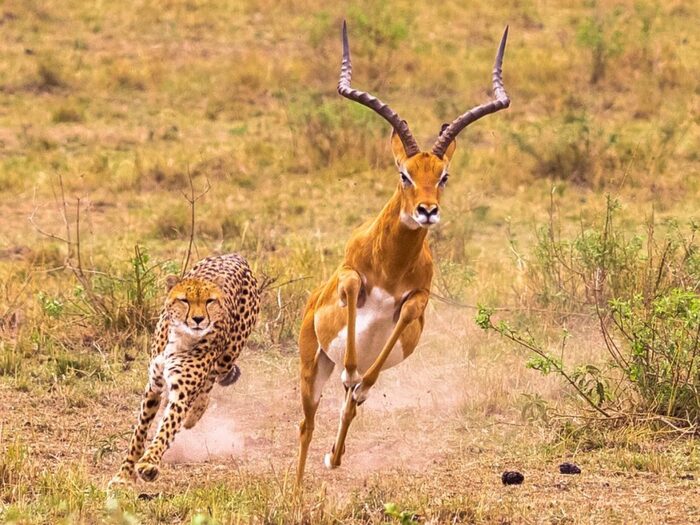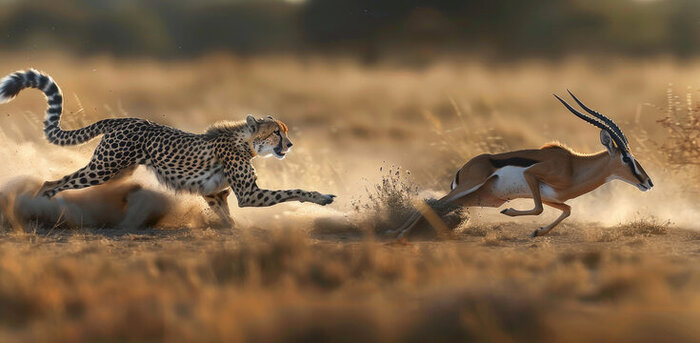The cheetah, often hailed as the "speed king" of the animal kingdom, holds the title of the fastest land animal on Earth. Reaching speeds of up to 60-70 mph (96-113 km/h) in short bursts, it’s no wonder this big cat has captivated biologists, wildlife enthusiasts, and speed lovers alike. But what exactly makes the cheetah such an extraordinary runner? Let’s dive into the anatomy, physiology, and evolutionary traits that make this feline a true speedster.

Cheetah and Gazelle Speed Showdown
The cheetah’s speed is its most famous feature. In an ideal chase, a cheetah can accelerate from 0 to 60 mph in just 3 seconds—rivaling the acceleration of some high-performance sports cars! However, this incredible burst of speed can only be sustained for about 20-30 seconds due to the immense physical strain it places on the animal’s body.
The cheetah's skeletal design is built for speed. It has a lightweight frame and long, slender limbs that reduce body weight and allow for greater stride length. During a sprint, a cheetah’s stride can reach up to 25 feet (7.6 meters) per leap!
Cheetahs have an unusually high percentage of fast-twitch muscle fibers. These muscles generate explosive power, allowing the cheetah to accelerate quickly and maintain top speeds during a chase.
The cheetah's spine acts like a spring, flexing and extending with each stride. This flexibility allows the cheetah to maximize its stride length and create the iconic leaping motion seen during its sprints.
Cheetahs are equipped with an oversized heart and lungs relative to their body size. This combination ensures a rapid supply of oxygen-rich blood to the muscles during a sprint. Their respiratory rate can increase from 60 breaths per minute to an astonishing 150 breaths per minute during a chase.
The cheetah’s tail acts as a counterbalance and rudder. When chasing agile prey like gazelles, the tail helps the cheetah make sharp turns at high speeds without losing balance. This functionality is crucial in outmaneuvering prey.
While the cheetah’s speed is unmatched, it has its drawbacks. Sprinting uses up tremendous energy, causing the cheetah to overheat if it runs for too long. After a chase, it needs 30-40 minutes to recover before it can hunt again.
Cheetah vs. Humans: Usain Bolt, the fastest human, reached a top speed of 27.8 mph (44.7 km/h), far behind a cheetah.
Cheetah vs. Greyhound: Greyhounds can hit speeds of 45 mph (72 km/h), but they can’t match the cheetah’s acceleration.
Cheetah vs. Gazelle: Gazelles are swift and can sustain speeds of 50 mph for longer durations, making them challenging prey.

Cheetah hunting gazelle
The cheetah's speed is a product of millions of years of evolution. It evolved in open grasslands, where chasing down fast-moving prey like antelopes became a survival necessity. Over time, the cheetah developed specialized adaptations, including its body shape, muscle function, and unique hunting techniques.
Despite their incredible abilities, cheetahs face significant threats, including habitat loss, human-wildlife conflict, and declining prey availability. There are fewer than 7,000 cheetahs left in the wild, making them a vulnerable species.
A cheetah can sustain its top speed for 20-30 seconds before exhaustion sets in.
Sprinting places immense strain on the cheetah's body, causing overheating and energy depletion.
No, the peregrine falcon holds the overall speed record, diving at speeds of over 240 mph (386 km/h). The cheetah is the fastest on land.
The cheetah’s unmatched speed is a testament to nature’s ingenuity. Its unique anatomy, physiological adaptations, and evolutionary traits combine to create a perfect sprinter. However, this majestic animal’s survival depends on our conservation efforts. Protecting their habitats and reducing human interference are crucial steps to ensure future generations can marvel at the planet’s fastest land animal.
animal tags: cheetah
We created this article in conjunction with AI technology, then made sure it was fact-checked and edited by a Animals Top editor.